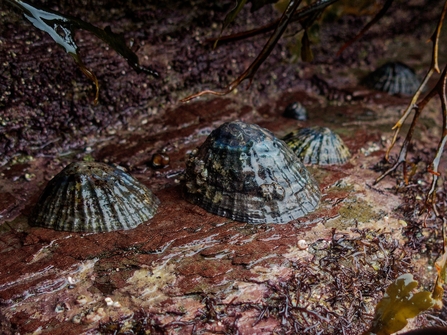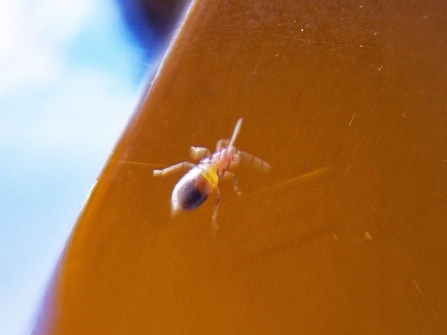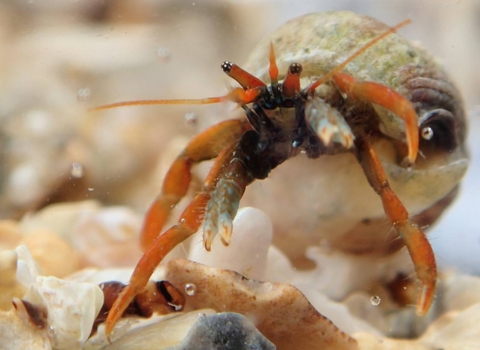Shoresearch 2023
Celebrating Shoresearch week 2023
Scooby Doo flat periwinkle. Image by Charlotte Cumming
Every year during Shoresearch Week we visit five of Cornwall’s Voluntary Marine Conservation Areas: Cowrie cove at Polzeath, Trevaunance cove in St Agnes, Hannafore in Looe, Prisk cove on the Helford and Readymoney cove in Fowey. Eighty quadrats were surveyed overall.
Zeni Hayton, Shoresearch volunteer coordinator said:
"Shoresearch surveys are awesome because you always find something exciting, it’s like a treasure hunt for sea creatures, whilst also gathering important data.”
This year, as always, there were many exciting finds. Here are just a few examples of what was discovered…

Devil's tongue weed, found in Looe. Image by Charlotte Cumming
Devil's tongue weed
This is a recent arrival to Cornish shores originating in eastern Asia and parts of east Russia – it feels really slippery to the touch, hence the name! It can grow very long with fronds over one meter in length, making it the largest red seaweed in the world. It is common on most shores, particularly on the south coast.

Limpets by Charlotte Cumming
Blue Limpets!
One thing that was noticed this year by our volunteers was that on most shores we came across, limpets had been eroded, making them appear blue! We are not sure why this has been seen this year but it has not been noticed before. The colour is extraordinary. Something to investigate!
Spotted cowrie. Image by Matt Slater
Cowrie: Trivia monacha and Trivia arctica
Lots of these were found at all of our Shoresearch sites this year except for Fowey. These beautiful creatures are smaller versions of those found in the tropics. They feed on sea squirts, including the beautiful Star ascidian.

Marine bug. Image by Charlotte Cumming
Marine bug Aepophilus bonnairei
A marine bug was found by Charlotte Cumming on the low shore among seaweeds at St Agnes. This is a rarely recorded species; one of only a handful of insects that can survive on the shore.
Small spotted cat shark. Image by Zeni Hayton
Shark eggs
At Hannafore point at low tide and at Prisk cove, volunteers found shark egg cases wrapped around seaweed. These nursery areas have been little-studied but seem to be very important for both greater and lesser spotted cat sharks. One egg case was found by Keith Hiscock that had a tiny embryo cat shark moving about inside!
Broad clawed porcelain crab. Image by Matt Slater
Broad clawed porcelain crab
Specially adapted for life on the shore, these crabs live beneath rocks and filter feed to catch plankton. They have flattened bodies and cling on to the rocks using hooked tipped legs. They are covered in hairs making them really shaggy looking.
Small headed clingfish. Image by Josh Symes
Cling fish
There were two species of clingfish found this year. One was the Cornish sucker (Lepadogaster lepadogaster), which is also known as the shore clingfish. It has modified pelvic fins which form a fleshy sucker on the underside of the body, used to stick it to the underside of rocks! We also found several small clingfish, Apletodon sp, which only grow to approximately 4cm.

Daisy anemone found in Looe. Image by Charlotte Cumming
Daisy anemone Cereus pedunculatus
These beautiful anemones live in habitats where a thin layer of sand is found over rocks, often in the bottom of rockpools. They have a large upper surface with a huge number of short tentacles around their mouth. When disturbed they can disappear completely into the sand.
Shoresearch team in St Agnes
All the records gathered by Shoresearch will be made available for all by the Environmental Records Centre for Cornwall and the Isles of Scilly (ERCCIS). The information helps us monitor change on the shore and provides biological information to counter potential threats. It has been particularly useful in gathering information on areas being considered as Marine Conservation Zones by the government in recent years and will be vital in monitoring these areas in future.


